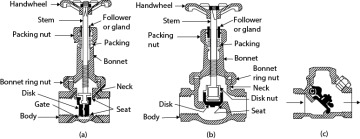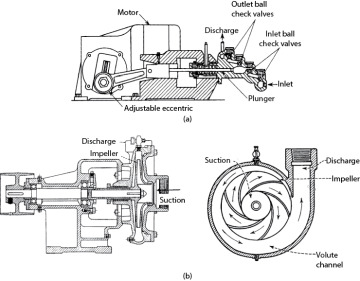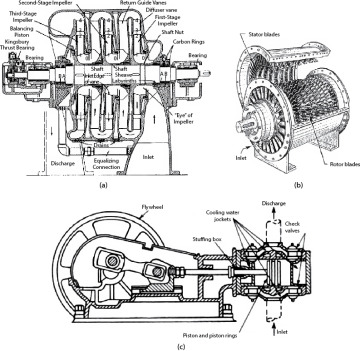19.2 Fluid Flow Equipment
The basic characteristics of fluid flow equipment are introduced in this section. The performance of pumps and compressors is dictated by their characteristic curves and, for pumps, the net positive suction head curve. The performance of these pieces of equipment is discussed in Section 19.5.
19.2.1 Pipes
Pipes and their associated fittings that are used to transport fluid through a chemical plant are usually made of metal. For noncorrosive fluids under conditions that are not of special concern, carbon steel is typical. For more extreme conditions, such as higher pressure, higher temperature, or corrosive fluids, stainless steel or other alloy steels may be needed. It may even be necessary, for very-high-temperature service such as for the flow of molten metals, to use refractory-lined pipes.
Pipes are sized using a nominal diameter and a schedule number. The higher the schedule number, the thicker the pipe walls, making pipes with a higher schedule number more suitable for higher-pressure operations. The nominal diameter is a number such as 2 in; however, there is no dimension of the pipe that is actually 2 in until the diameter reaches 14 in. For pipes with a diameter of 14 in or larger, the nominal diameter is the outside diameter. Pipes typically have integer nominal diameters; however, for smaller diameters, they can be in increments of 0.25 in. At larger diameters, the nominal diameters may only be even integer values. Table 19.1 shows the dimensions of some schedules of standard pipe.
Table 19.1 Dimensions of Standard Steel Pipe
Nominal Size (in) |
Outside Diameter |
Schedule Number |
Wall Thickness |
Inside Diameter |
Inside Cross-Sectional Area |
||||
in |
mm |
in |
mm |
in |
mm |
102ft2 |
104m2 |
||
1/8 |
0.405 |
10.29 |
40 |
0.068 |
1.73 |
0.269 |
6.83 |
0.040 |
0.3664 |
80 |
0.095 |
2.41 |
0.215 |
5.46 |
0.025 |
0.2341 |
|||
1/4 |
0.540 |
13.72 |
40 |
0.088 |
2.24 |
0.364 |
9.25 |
0.072 |
0.6720 |
80 |
0.119 |
3.02 |
0.302 |
7.67 |
0.050 |
0.4620 |
|||
3/8 |
0.675 |
17.15 |
40 |
0.091 |
2.31 |
0.493 |
12.52 |
0.133 |
1.231 |
80 |
0.126 |
3.20 |
0.423 |
10.74 |
0.098 |
0.9059 |
|||
1/2 |
0.840 |
21.34 |
40 |
0.109 |
2.77 |
0.622 |
15.80 |
0.211 |
1.961 |
80 |
0.147 |
3.73 |
0.546 |
13.87 |
0.163 |
1.511 |
|||
3/4 |
1.050 |
26.67 |
40 |
0.113 |
2.87 |
0.824 |
20.93 |
0.371 |
3.441 |
80 |
0.154 |
3.91 |
0.742 |
18.85 |
0.300 |
2.791 |
|||
1 |
1.315 |
33.40 |
40 |
0.133 |
3.38 |
1.049 |
26.64 |
0.600 |
5.574 |
80 |
0.179 |
4.45 |
0.957 |
24.31 |
0.499 |
4.641 |
|||
1 1/4 |
1.660 |
42.16 |
40 |
0.140 |
3.56 |
1.380 |
35.05 |
1.040 |
9.648 |
80 |
0.191 |
4.85 |
1.278 |
32.46 |
0.891 |
8.275 |
|||
1 1/2 |
1.900 |
48.26 |
40 |
0.145 |
3.68 |
1.610 |
40.89 |
1.414 |
13.13 |
80 |
0.200 |
5.08 |
1.500 |
38.10 |
1.225 |
11.40 |
|||
2 |
2.375 |
60.33 |
40 |
0.154 |
3.91 |
2.067 |
52.50 |
2.330 |
21.65 |
80 |
0.218 |
5.54 |
1.939 |
49.25 |
2.050 |
19.05 |
|||
2 1/2 |
2.875 |
73.03 |
40 |
0.203 |
5.16 |
2.469 |
62.71 |
3.322 |
30.89 |
80 |
0.276 |
7.01 |
2.323 |
59.00 |
2.942 |
27.30 |
|||
3 |
3.500 |
88.90 |
40 |
0.216 |
5.59 |
3.068 |
77.92 |
5.130 |
47.69 |
80 |
0.300 |
7.62 |
2.900 |
73.66 |
4.587 |
42.61 |
|||
3 1/2 |
4.000 |
101.6 |
40 |
0.226 |
5.74 |
3.548 |
90.12 |
6.870 |
63.79 |
80 |
0.318 |
8.08 |
3.364 |
85.45 |
6.170 |
57.35 |
|||
4 |
4.500 |
114.3 |
40 |
0.237 |
6.02 |
4.026 |
102.3 |
8.840 |
82.19 |
80 |
0.337 |
8.56 |
3.826 |
97.18 |
7.986 |
74.17 |
|||
5 |
5.563 |
141.3 |
40 |
0.258 |
6.55 |
5.047 |
128.2 |
13.90 |
129.1 |
80 |
0.375 |
9.53 |
4.813 |
122.3 |
12.63 |
117.5 |
|||
6 |
6.625 |
168.3 |
40 |
0.280 |
7.11 |
6.065 |
154.1 |
20.06 |
186.5 |
80 |
0.432 |
10.97 |
5.761 |
146.3 |
18.10 |
168.1 |
|||
8 |
8.625 |
219.1 |
40 |
0.322 |
8.18 |
7.981 |
202.7 |
34.74 |
322.7 |
80 |
0.500 |
12.70 |
7.625 |
193.7 |
31.71 |
294.7 |
|||
10 |
10.75 |
273.1 |
40 |
0.365 |
9.27 |
10.02 |
254.5 |
54.75 |
508.6 |
80 |
0.594 |
15.09 |
9.562 |
242.8 |
49.87 |
463.3 |
|||
12 |
12.75 |
304.8 |
40 |
0.406 |
10.31 |
11.94 |
303.3 |
77.73 |
722.1 |
80 |
0.688 |
17.48 |
11.37 |
288.8 |
70.56 |
655.5 |
|||
14 |
14 |
355.6 |
40 |
0.438 |
11.13 |
13.12 |
333.2 |
93.97 |
873.0 |
80 |
0.750 |
19.05 |
12.50 |
317.5 |
85.22 |
791.7 |
|||
16 |
16 |
406.4 |
40 |
0.500 |
12.70 |
15.00 |
381.0 |
122.7 |
1140 |
80 |
0.844 |
21.44 |
14.31 |
363.5 |
111.7 |
1038 |
|||
18 |
18 |
457.2 |
40 |
0.562 |
14.27 |
16.88 |
428.8 |
155.3 |
1443 |
80 |
0.938 |
23.83 |
16.12 |
409.4 |
141.8 |
1317 |
|||
20 |
20 |
508.0 |
40 |
0.597 |
15.16 |
18.81 |
477.8 |
193.0 |
1793 |
80 |
1.031 |
26.19 |
17.94 |
455.7 |
175.5 |
1630 |
|||
24 |
24 |
635.0 |
40 |
0.688 |
17.48 |
22.62 |
574.5 |
279.2 |
2594 |
80 |
1.219 |
30.96 |
21.56 |
547.6 |
253.6 |
2356 |
|||
Source: Adapted from Geankoplis, C., Transport Processes and Separation Process Principles, 4th ed., Prentice Hall, Upper Saddle River, 2003 [1]; Perry, R. H., and D. Green, Perry’s Chemical Engineers’ Handbook, 6th ed., McGraw-Hill, New York, 1984, Section 5 [2]. |
|||||||||
Tubing is commonly used in heat exchangers. The dimensions and use of tubing are discussed in Chapter 20.
Pipes are typically connected by screw threads, flanges, or welds. Welds and flanges are more suitable for larger diameters and higher-pressure operation. Proper welds are stronger and do not leak, whereas screwed or flanged connections can leak, especially at higher pressures. Changes in direction are usually accomplished by elbows or tees, and those changes in direction are usually 90°.
19.2.2 Valves
Valves are found in piping systems. Valves are about the only way to regulate anything in a chemical process. Valves serve several functions. They are used to regulate flowrate, reduce pressure by adding resistance, or isolate (turn flow on/off) equipment.
Two common types of valves are gate valves and globe valves. Figure 19.3 shows illustrations of several common types of valves.

Figure 19.3 Common Types of Valves: (a) Gate, (b) Globe, (c) Swing Check (Reproduced by Permission from Couper, J. R. et al. Chemical Process Equipment: Selection and Design, 3rd ed. [New York, Elsevier, 2012] [3])
Gate valves are used for on/off control of fluid flow. The flow path through a gate valve is roughly straight, so when the valve is fully open, the pressure drop is very small. However, gate valves are not suitable for flowrate regulation because the flowrate does not change much until the “gate” is almost closed. There are also ball valves, in which a quarter turn opens a flow channel, and they can also be used for on/off regulation.
Globe valves are more suitable than gate valves for flowrate and pressure regulation. Because the flow path is not straight, globe valves have a higher pressure drop even when wide open. Globe valves are well suited for flowrate regulation because the flowrate is responsive to valve position. In a control system, the valve stem is raised or lowered pneumatically (by instrument air) or via an electric motor in response to a measured parameter, such as a flowrate. Pneumatic systems can be designed for the valve to fail open or closed, the choice depending on the service. Failure is defined as loss of instrument air pressure. For example, for a valve controlling the flowrate of a fluid removing heat from a reactor with a highly exothermic reaction, the valve would be designed to fail open so that the reactor cooling is not lost.
Check valves, such as the swing check valve, are used to ensure unidirectional flow. In Figure 19.3(c), if the flow is left to right, the swing is opened and flow proceeds. If the flow is right to left, the swing closes, and there is no flow in that direction. Such valves are often placed on the discharge side of pumps to ensure that there is no flow reversal through the pump.
19.2.3 Pumps
Pumps are used to transport liquids, and pumps can be damaged by the presence of vapor, a phenomenon discussed in Section 19.5.2. The two major classifications for pumps are positive displacement and centrifugal. For a more detailed summary of all types of pumps, see Couper et al. [3] or Green and Perry [4].
Positive-displacement pumps are often called constant-volume pumps because a fixed amount of liquid is taken into a chamber at a low pressure and pushed out of the chamber at a high pressure. The chamber has a fixed volume, hence the name. An example of a positive-displacement pump is a reciprocating pump, illustrated in Figure 19.4(a). Specifically, this is an example of a piston pump in which the piston moves in one direction to pull liquid into the chamber and then moves in the opposite direction to discharge liquid out of the chamber at a higher pressure. There are other variations of positive-displacement pumps, such as rotary pumps in which the chamber moves between the inlet and discharge points. In general, positive-displacement pumps can increase pressure more than centrifugal pumps and run at higher pressures overall. These characteristics define their applicability. Efficiencies tend to be between 50% and 80%. Positive-displacement pumps are preferred for higher pressures, higher viscosities, and anticipated viscosity variations.

Figure 19.4 (a) Inner Workings of Positive-Displacement Pump, (b) Inner Workings of Centrifugal Pump ([a] Reproduced by Permission from McCabe, W. L. et al., Unit Operations of Chemical Engineering, 5th ed. [New York, McGraw−Hill, 1993] [5]; [b] Reproduced by Permission from Couper, J. R. et al., Chemical Process Equipment: Selection and Design, 3rd ed. [New York, Elsevier, 2012] [3])
In centrifugal pumps, which are a common workhorse in the chemical industry, the pressure is increased by the centrifugal action of an impeller. An impeller is a rotating shaft with blades, and it might be tempting to call it a propeller because an impeller resembles a propeller. (While there might be a resemblance, the term propeller is reserved for rotating shafts with blades that move an object, such as a boat or airplane.) The blades of an impeller have small openings, known as vanes, that increase the kinetic energy of the liquid. The liquid is then discharged through a volute in which the kinetic energy is converted into pressure. Figure 19.4(b) shows a centrifugal pump. Centrifugal pumps often come with impellers of different diameters, which enable pumps to be used for different services (different pressure increases). Of course, shutdown is required to change the impeller. Although standard centrifugal pump impellers only spin at a constant rate, variable-speed centrifugal pumps also are available.
Centrifugal pumps can handle a wide range of capacities and pressures, and depending on the exact type of pump, the efficiencies can range from 20% to 90%.
19.2.4 Compressors
Devices that increase the pressure of gases fall into three categories: fans, blowers, and compressors. Figure 19.5 illustrates some of this equipment. For a more detailed summary of all types of pumps, see Couper et al. [3] or Green and Perry [4].

Figure 19.5 Inner Working of Compressors: (a) Centrifugal, (b) Axial, (c) Positive Displacement ([a] and [b] Reproduced by Permission from Couper, J. R. et al., Chemical Process Equipment: Selection and Design, 3rd ed. [New York: Elsevier, 2012]; [c] Reproduced by Permission from McCabe, W. L. et al., Unit Operations of Chemical Engineering, 5th ed. [New York: McGraw−Hill, 1993])
Fans provide very low-pressure increases (<1 psi [7 kPa]) for low volumes and are typically used to move air. Blowers are essentially mini-compressors, providing a maximum pressure of about 30 psi (200 kPa). Blowers can be either positive displacement or centrifugal, and while their general construction is similar to pumps, there are many internal differences. Compressors, which can also be either positive displacement or centrifugal, can provide outlet pressures of 1500 psi (10 MPa) and sometimes even 10 times that much.
In a centrifugal compressor, the impeller may spin at tens of thousands of revolutions per minute. If liquid droplets or solid particles are present in the gas, they hit the impeller blades at such high relative velocity that the impeller blades will erode rapidly and may cause bearings to become damaged, leading to mechanical failure. The compressor casing also may crack. Therefore, it is important to ensure that the gas in a centrifugal compressor does not contain solids and liquids. A filter can be used to keep particles out of a compressor, and a packed-bed adsorbent can also be used, for example, to remove water vapor from inlet air. Knockout drums are often provided between compressor stages with intercooling to allow the disengagement of any condensed drops of liquid and are covered in more detail in Chapter 23, Section 23.2. The seals on compressors are temperature sensitive, so a maximum temperature in one stage of a compressor is generally not exceeded, which is another reason for staged, intercooled compressor systems. It should also be noted that compressors are often large and expensive pieces of equipment that often have a large number of auxiliary systems associated with them. The coverage given in this text is very simplified but allows the estimate of the power required.
Positive-displacement compressors typically handle lower flowrates but can produce higher pressures compared to centrifugal compressors. Efficiencies for both types of compressor tend to be high, above 75%.
